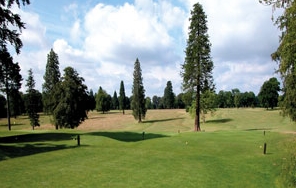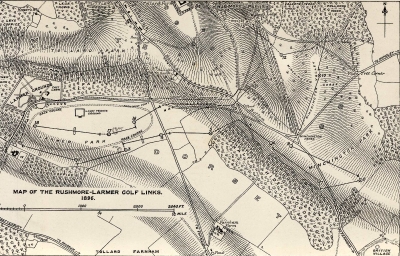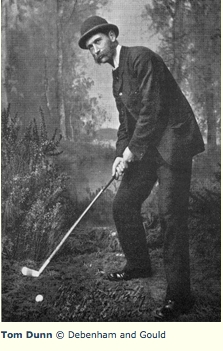To search the RPR site click here
Rushmore Golf Course
This booklet, produced in the same series as the guide to the Larmer Grounds, Farnham Museum and King John's House, is transcribed below. It is not clear when it was first written and published but it was after Spring 1896 and may have been written after Pitt-Rivers' death. Find out more about the golf course today here. It was taken from the copy in the Pitt Rivers Museum, Manuscript Collections, Pitt-Rivers Pamphlet Collection, item X.:
THE RUSHMORE-LARMER GOLF LINKS
These links were constructed by General Pitt-Rivers in the spring of the year 1896, as an addition to the amusements of the Larmer Grounds. Mr Thomas Dunn, of Bournemouth, the well-known Golf Professional, planned them and superintended their construction. [1]
It is intended that all visitors to the Larmer Grounds shall be free to play Golf on the payment of a fee to the Caretaker, and writing their names in a book provided for the purpose.
The charges are 6d. for Gentlemen and 3d. for Ladies for the day's play. [2] These charges are made as a contribution towards the maintenance of the Links and are liable to alteration.
Golf clubs may be hired and Golf balls bought at the Larmer Lodge. The charge for the hire of clubs is £d. per club and 1s. for a set. Clubs that are damaged or broken must be paid for at cost price.
The players will be required to adhere strictly to the Rules and Regulations laid down for observance on these Links.
All players will purchase a ticket at the Lodge, which will entitle the holder to play on the Links for the day.
It is advisable that players should wear the usual red coat when possible. [3] This is, however, optional.
THE RUSHMORE-LARMER GOLF CLUB
The Members of this Club have the use of the New Rooms at the Larmer, where they can obtain refreshments at cheap rates. Apart from the advantages of privacy and accommodation thus secured, it will be the duty of the Club Committee to consider any suggestions for improvement made by Members, and accord them any reasonable privileges consistent with the comfort and freedom of casual visitors.
The annual Club subscription for Members is 5s. for Gentlemen and 2s. 6d. for Ladies. There is no entrance fee. [4]
Members of the Club are to purchase tickets at the Lodge for the day's play on the same terms as the public, viz.:- Gentlemen 6d. and Ladies 3d. per diem.
Members, if they prefer it, may pay, Gentlemen £1 and Ladies 10s. [5] This will include Membership, and entitle them to play all the year round without further expense.
Members may invite their friends to the Club Rooms, who will pay the same price for their playing tickets as the rest.
Further Regulations will be made, if found desirable, at a later date, when the requirements of the Club become better known.
Ladies and Gentlemen who desire to join the Club are requested to communicate with EDWARD CASTLEMAN, Esq., Hon. Sec. and Treasurer, Chettle Lodge, Blandford. [6]
All complaints should be made in writing to the Hon. Sec., who, if unable to deal with them himself, will submit them to the Committee.
------
Lawn Tennis Grounds have also been provided, which will be open to the Club and the other visitors. Rackets and Lawn Tennis balls may be hired at the Lodge. There is no charge made for playing Lawn Tennis.
LAWS OF THE GAME OF GOLF
AS PLAYED BY
THE ROYAL AND ANCIENT GOLF CLUB OF ST. ANDREWS, 1888.
I. MODE AND ORDER OF PLAYING THE GAME
1. The game of Golf is generally played by two sides. Each side may consist either of one person or of two, who play alternately. It may also be played by three or more sides, each playing its own ball.
2. The game commences by each side playing off a ball from a place called the "teeing-ground," for the first hole. In a match with two on a side, the partners shall strike off alternately from the tee; and the players opposed to each other shall be named at starting, and shall continue in the same order during the match. The player entitled to play off first shall be named by the parties themselves, and his side shall continue to lead off till they lose a hole; and although the courtesy of starting is generally granted to Captains of the Club and old Members, it may be settled by lot or toss of a coin.
3. The hole is won by the side holing at fewest strokes; and the reckoning of the strokes is made by the terms "odds" and "like," "two more," "three more," "one off two," &c.
4. The side gaining a hole shall lead at the next, except at the commencement of a new match, in which case the winner of the previous match is to lead, and is entitled to claim his privilege and recall his opponent's stroke should he play out of order. The privilege is called the "honour."
5. One round of the Links is reckoned a match, unless otherwise stipulated. The match is won by the side which wins one or more holes, in excess of the number of holes remaining to be played.
6. If, in a double match, a player shall play when his partner should have done so, his side loses the hole.
II. PLACE OF TEEING, AND PLAYING THROUGH THE GREEN.
7. The ball must be teed within the marks laid down by the Conservator of the Links, which shall be considered the "teeing-ground." The balls shall not be teed in advance of such marks, nor more than two club lengths behind them.
8. A ball played in contravention of this Rule may be recalled by the opposite side.
9. After teh balls are struck off, the ball furthest from the hole to which the partners are playing must be played first. No player shall play his teed ball till the party in front have played their second strokes; nor play on to the putting-green till the party in front of him has holed out. (It is requested that when a party is waiting to approach the hole, the party that is "holed out" will not cause delay by trying their putts over again.)
III. CHANGING THE BALLS
10. The balls struck off from the tee must not be changed, touched, or moved, before the hole is played out (except in striking, and the cases provided for by Rules IV, V, VII, VIII, IX, XIII, and XVI); and if the sides are at a loss to know one ball from the other, neither shall be touched without the consent of both.
IV. LIFTING OF BREAK CLUBS
11. All loose impediments within a club length of the ball may be removed, unless the ball lies within a bunker, on sand, on a molehill, on a road, or other hazard, or touching a growing whin (Rules VI, IX, XII)
12. When the ball lies in a bunker, sand, or any other hazard, there shall be no impression made by the club whilst addressing the ball, nor sand nor other obstacle removed "before striking at the ball."
13. A ball lying in sand, sprinkled on grass on the course for the preservation of the Links, shall be treated as if it lay on grass.
14. On no occasion is it allowable to press down any irregularities of surface to improve the lie of the ball.
15. When a ball lies near a washing-tub or implements used in the up-keep of the Links, they may be removed, and when on clothes, the ball may be lifted and dropped behind them without penalty.
V. ENTITLED TO SEE THE BALL
16. When a ball is completely covered with fog, bent whins &c., only so much thereof shall be set aside as that the player shall have a view of his ball before he plays whether in a line with the hole or otherwise.
17. Nothing that is growing may be bent, broken, or removed, except in the act of striking at the ball, or in the special occasion provided for in par. 16.
18. A ball stuck fast in wet ground or sand may be taken out and placed loosely in the hole it has made
VI. CLEARING THE PUTTING-GREEN
19. All loose impediments, except the opponent's ball, may be lifted on the putting-green.
20. The term "putting-green" shall be considered to mean those portions of the Links devoid of hazards within 20 yards of a hole. When ice or snow lies on the putting-green, parties are recommended to make their own arrangements as to its removal or not, before commencing their match.
VII. LIFTING BALLS
21. When the balls lie within six inches of each other, in any situation, the ball nearer the hole to which the parties are playing must be lifted till the other is played, and then placed as nearly as possible in its original position. Should the ball furthest from the hole be accidentally moved in so doing, it must be replaced without a penalty. The six inches to be measured from the nearest surface of the balls.
22. In a three or more ball match, a ball in any degree lying between the player and the hole must be lifted as above, or, if on the putting-green, holed out.
VIII. BALL IN WATER
23. If the ball lie in the water, [sic] the player may take it out, change it if he pleases, drop it, and play from behind the hazard, losing a stroke.
IX. RUBS OF THE GREEN AND PENALTIES
24. Whatever happens to a ball by accident, such as being moved or stopped by any person not engaged in the match, or by the fore caddie, must be reckoned a "Rub on the Green" and submitted to.
25. If, however, the player's ball strike his opponent or his opponent's caddie or club, or is moved by them, the opponent loses the hole.
26. If the ball strike himself or his partner, or either of their caddies or clubs, or is stopped by them, or if, while in the act of playing, he strikes the ball twice, the player loses the hole.
26. If the ball strikes himself or his partner, or either of their caddies or clubs, or is stopped by them, or if, while in the act of playing, he strikes the ball twice, the player loses the hole.
27. If the player or his partner touch their ball with the foot or any part of the body (except as provided for in Rules IV, V, VII and VIII), or with anything except the club, his side loses a stroke.
28. If the player, whilst addressing himself to the ball, on any occasion, except at the tee, touch it so as to cause it to move, or if his hand, foot or club touch a bent, stick, or anything which causes the ball to move, or if the player's caddie moves the ball, he loses a strike.
29. A ball is considered to have been moved if it leaves its original position in the least degree, and stops in another; but if a player touches his ball so as to make it merely oscillate and not leave its original position, it is not considered to have been moved.
30. If a player or his caddie strike the opponent's ball in any manner, that side loses the hole; but if he plays it inadvertently, thinking it is own, and the opponent also plays the wrong ball, it is then too late to claim the penalty, and the hole must be played out with the balls thus changed. If, however, the mistakes occurs from wrong information given by one party to the other, the penalty cannot be claimed, and the mistake, if discovered before the other party has played, must be rectified by replacing the ball as nearly as possible where it lay.
31. If a player’s ball be played away by mistake, or be lifted by any agency outside the match, then the player must drop it, or another ball, as near the spot as possible without any penalty. Should this occur on the putting-green the ball may be replaced by hand.
X. BALL LOST
32. In match playing, a ball lost entails the loss of the hole. Should the ball not be found within ten minutes, the opposite side can claim the hole.
XI. CLUB BREAKING
33. If, in striking, the club breaks, it is nevertheless to be counted a stroke, if the part of the club remaining in the player’s hand either strike the ground or pass the ball.
XII. HOLING OUT THE BALL
34. In holing, no mark shall be placed, or line drawn, to indicate the line to the hole; the ball must be played fairly and honestly for the hole, and not on the opponent’s ball, not being in the way to the hole; nor although lying in the way to the hole is the player entitled to play with any strength upon it that might injure his opponent’s position, or greater than is necessary honestly to send his own ball the distance of the hole.
35. Either player, when it is his turn to play, may remove, but not press down, sand, or worm heaps, lying around the hole, or on the line of his "putt"; but this must be done lightly by the player or his caddie, with the hand only. Except as above mentioned, or when the player is in the act of addressing himself to the ball, the putting line must not be touched by club, hand, nor foot. If the player desires the "line to the hole", it may be pointed out by a club shaft only.
36. If, in holing out, the ball rest upon the flag-stick in the hole, the player shall be entitled to have the stick removed, and if the ball fall in, it shall be considered as holed out; but either party is entitled to have the flag-stick removed when approaching the hole. When the player’s ball rests on the lip of the hole, his opponent, after holing in the "odd" or the "like" shall be entitled to strike way the ball which is at the lip of the hole, claiming the hole if he shall have holed in the "like"; and the "half" if he shall have holed in the "odd". But no player shall be entitled to play until his opponent’s ball shall have ceased rolling.
XIII. UNPLAYABLE BALLS
37. In Match playing every ball must be played, wherever it lies, or the hole given up, excepting where otherwise provided for (Rules IV and VIII).
38. If a ball lies in any of the holes made for golfing, or on ground under repair by the conservator of the links, it may be lifted, dropped behind the hazard, and played without losing a stroke.
39. In all cases where a ball is to be dropped, the party doing so shall front the hole to which he is playing, standing behind the hazard, and dropping the ball behind him from his head.
XIV. ASKING ADVICE
40. A player must not ask advice about the game, by word, look, or gesture, from any one except his own caddie, his partner’s caddie, or his partner.
XV. PARTIES PASSING EACH OTHER
41. Any party having lost a ball, and incurring delay by seeking for it, may be passed by any other party coming up.
42. On all occasions a "two-ball" match may pass a party playing three or more balls.
43. Parties turning before going the whole round must let any two-ball match that has done so pass them.
XVI. BALLS SPLITTING
44. If a ball should split into two or more pieces, a fresh ball shall be put down where the largest portion of the ball lies; and if the ball is cracked the player may change it on intimating his intention of doing so to his opponent.
XVII. BREACH OF RULES
Where no penalty for the infringement of a rule is specially mentioned, the loss of the hole shall be understood to be the penalty.
Notes [not included in original text, added by transcriber]
[1] Tom Dunn (1850-1902) was a prolific designer of golf courses in the UK and abroad and a golf club maker. See a list of the golf courses he designed in London here. He was the golf professional at Meyrick Park golf course at Bournemouth from 1894. The photograph of him is taken from here.
[2] The equivalent of roughly £3 for men and £1.50 for women golfers.
[3] According to the British Golf Museum, 'In the 18th century, golfers wanted to stand out, both in society and on the course. Many clubs required their members to wear formal red jackets. Based on military jackets, they were essentially a uniform. Golfers could be fined by their club if not properly dressed. Today, red jackets are usually only worn for ceremonial occasions as a link to the past.'
[4] The annual fees for men were therefore just over £16 and for women just over £8.
[5] Just over £90 for men, £45 for women golfers
[6] Probably Edward Castleman (1870-1946) who also played cricket for Dorset. He owned Chettle House, and was apparently very keen on hunting. He married a rich heiress Jessie Morris who brought money to the estate.
The image of the golf course is taken from here.
Note that the map shows the race-course that Pitt-Rivers also provided for the public.
AP May 2012






